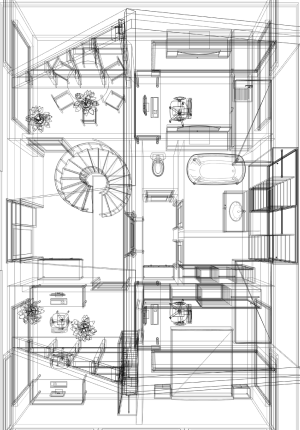Choosing the Right Ductwork for Your HVAC System

Selecting the perfect ductwork for your HVAC system is more than a mere technical decision. It’s about ensuring efficient airflow, optimizing energy consumption, and promoting a comfortable environment in your home. With various types of ductworks available, making the right choice can be a tad overwhelming. But did you know that not all ducts are made the same? The material of your ductwork plays a pivotal role in efficiency, longevity, and overall performance. Dive into this guide to understand the nuances of various ductwork materials.
Metal Ducts (Galvanized Steel or Aluminum): Commonly found in many homes and commercial buildings, metal ducts are a staple in the HVAC world. Their robust nature ensures they last for decades, and their non-porous surface keeps mold at bay. Moreover, their fire resistance provides an added safety layer.
Galvanized Steel Ducts
In commercial buildings, such as offices, hospitals, and factories, galvanized steel ducts are a popular choice. Their ability to withstand high temperatures and resist corrosion makes them a safe and reliable option for ventilation systems. They are highly fire-resistant, making them ideal for applications where fire safety is a primary concern. They can withstand high temperatures without deforming or releasing harmful fumes, helping to contain fires and protect occupants.
Aluminum Ducts
The lightweight properties of aluminum make it a practical choice for residential installations, where ease of handling and installation are significant considerations making them an attractive option for homeowners and contractors working within budget constraints. Like galvanized steel, aluminum ducts are corrosion resistant. They won’t rust or deteriorate over time, ensuring a longer lifespan in residential applications.
However, proper insulation is crucial for aluminum ducts to maintain energy efficiency. In residential settings, they are often insulated to prevent heat loss in winter and maintain overall system efficiency.
Fiberglass Lined Ducts: consist of an inner layer or lining made of fiberglass material. This lining is typically applied to the interior surface of the ducts, providing several unique properties. These are commonly used in commercial HVAC systems, where noise control and thermal insulation are critical factors. Examples include office buildings, hotels, hospitals, and schools.
However, moisture can be their nemesis, turning the fiberglass into a potential mold hub. Also, over time, there’s a concern of fiberglass particles dislodging and compromising indoor air quality. To maintain indoor air quality and prevent the accumulation of dust or debris within the ducts, regular cleaning and inspection of fiberglass lined ducts are recommended. Cleaning should be performed by professionals to minimize the release of fiberglass particles.
Flexible Ducts: These are the chameleons of the duct world, adapting to spaces traditional ducts can’t navigate. Their versatility allows for quicker and less invasive installations. They are also generally kinder to your wallet, with fewer fittings and joints required.
Yet, they aren’t without flaws. If not installed correctly, they can reduce airflow efficiency, and their durability doesn’t match up to their metal counterparts.
Fiberboard Ducts: are valued for their inherent insulative properties. The combination of resin and fiberglass provides natural thermal insulation, helping to reduce heat loss or gain within the ductwork. This insulation can contribute to energy efficiency in heating and cooling systems.
Like other duct materials, fiberboard ducts are sensitive to moisture. When exposed to moisture, they can become vulnerable to mold growth. As such, it’s crucial to prevent moisture infiltration and maintain a dry environment within the ductwork. To maximize the efficiency of fiberboard ducts, proper air sealing is essential. Gaps and leaks in the ducts can result in energy loss and reduced system performance. Using appropriate sealants, such as mastic sealant or specialized metal tape, is crucial for effective sealing.
Polyurethane and Phenolic Panel Ducts: These ducts are constructed using panels made of polyurethane foam sandwiched between two layers of rigid material, often aluminum or other sheet metals.
Both polyurethane and phenolic panel ducts are known for their lightweight properties, which can make them easier to handle and install compared to some other duct materials. The foam core within the panels provides efficient insulation, reducing heat loss or gain as air travels through the ducts. This can result in improved energy efficiency.
These ducts typically require specialized installation to ensure peak performance. Proper sealing and joining of panels are crucial to maintain energy efficiency. While polyurethane and phenolic panel ducts offer significant benefits, they can be more expensive than some other duct materials. However, the potential energy savings over time may offset the initial cost.
The material of the ductwork is just one aspect, however. There are other significant factors to weigh in when deciding on ductwork.
- Sizing: Proper sizing of ductwork is imperative to ensure your HVAC system runs efficiently. An HVAC specialist will typically conduct a Manual J calculation, which evaluates your home’s heating and cooling demands, followed by a Manual D calculation, determining the most efficient duct design.
- Insulation: Where your ducts travel, matters. If they snake through unconditioned spaces like attics or basements, insulation is non-negotiable. Insulated ducts curtail heat loss, fend off condensation, and subsequently, the threat of mold.
- Air Sealing: The best ductwork is only as good as its sealing. Gaps and leaks can be energy guzzlers, rendering even the most efficient HVAC systems ineffective. Using mastic sealant or metal tape (not your run-of-the-mill duct tape) to seal connections can make a world of difference.
Your choice in ductwork material isn’t just a technical decision; it’s an investment in comfort, efficiency, and long-term HVAC performance. As you contemplate your options, remember that an HVAC professional’s insights can be invaluable. Their expertise tailors’ recommendations to your home’s unique needs, ensuring that your ducts, quite literally, are in a row.
Choosing the right ductwork goes beyond aesthetics and budget. It’s about ensuring you maximize the efficiency of your HVAC system, guaranteeing a comfortable home environment, and optimizing energy use. While this guide offers a starting point, the insights of a seasoned HVAC contractor are invaluable. Our expertise can tailor recommendations to your home’s unique needs, ensuring optimal HVAC performance.
If you have any questions or want to talk about possible solutions for your home, send us an email at tom@procalcs.net


